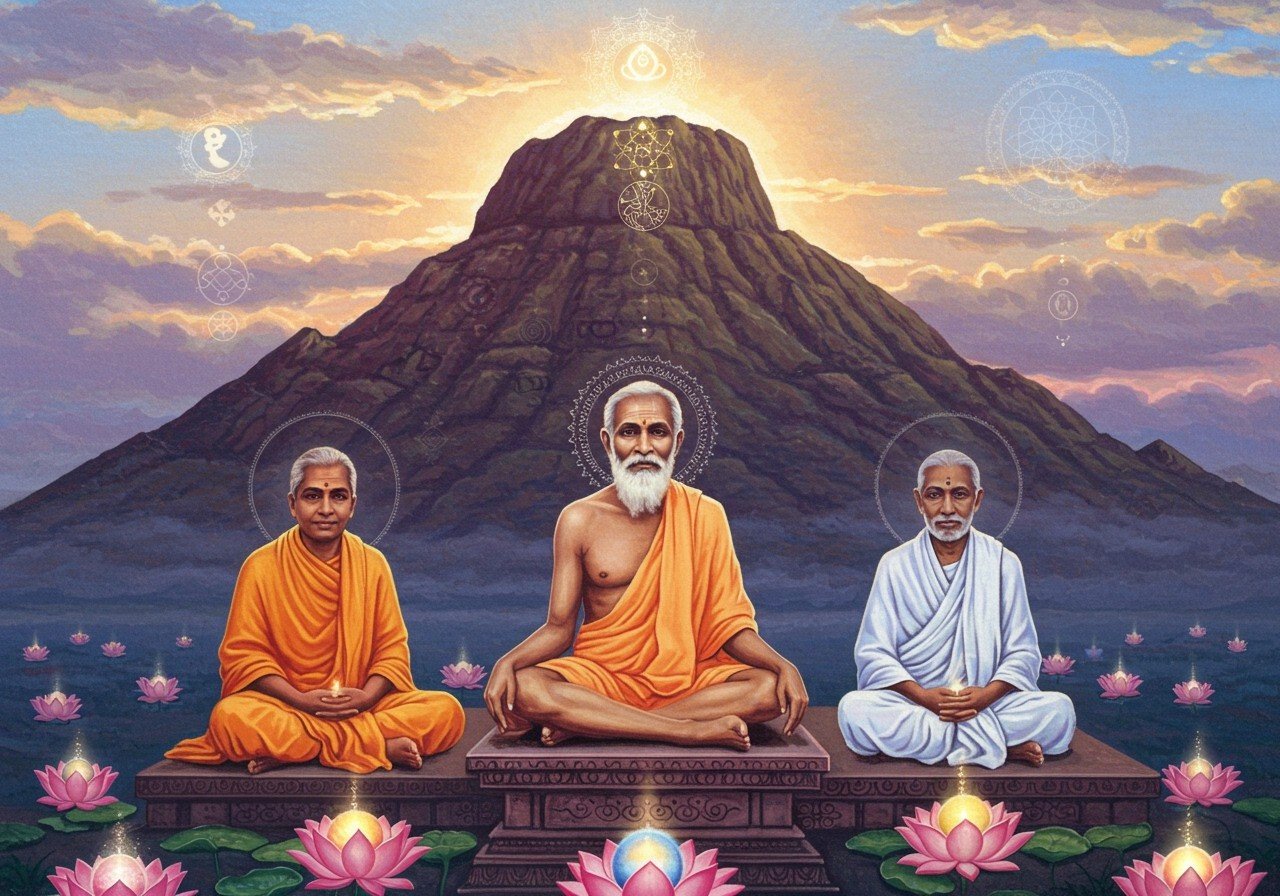
India’s spiritual heritage is a vibrant tapestry woven with the threads of countless enlightened souls. Among these shining lights, Ramana Maharshi stands as a beacon of self-inquiry and silent wisdom. Alongside other luminaries like Paramahansa Yogananda, Ramakrishna Paramahamsa, and Jiddu Krishnamurti, he has profoundly shaped the landscape of spiritual thought, offering unique pathways to self-discovery and liberation. Understanding their diverse teachings unveils a rich mosaic of spiritual ideologies that have touched the hearts and minds of millions across generations.
Ramana Maharshi and Yogananda: Two Paths, One Truth
Ramana Maharshi and Paramahansa Yogananda, while both guiding lights towards spiritual awakening, illuminated distinct paths. Ramana Maharshi’s teachings centered around the potent practice of self-inquiry, encapsulated in the profound question, “Who am I?”. This introspective journey, he believed, peels back the layers of the ego, revealing the true Self, one with the ultimate reality, Brahman. Paramahansa Yogananda, on the other hand, championed Kriya Yoga, a powerful blend of meditation and breath control, as the key to unlocking spiritual realization. Both masters, however, shared the same aim. They guided the seekers of truth to understand themselves and to merge into the divine power.
Maharshi’s influence, though deeply felt, was largely centered in India, particularly around his sacred Arunachala Hill. His teachings emphasized the transformative power of silent presence and deep meditation, creating a ripple effect that continues to inspire seekers of inner peace. Yogananda, through his influential “Autobiography of a Yogi,” bridged the East and West, introducing the transformative power of yoga to a global audience. His work sparked a worldwide embrace of yogic practices, igniting a flame of spiritual seeking in countless hearts.
Both masters enriched spiritual literature in their own unique ways. Maharshi’s recorded teachings delve deep into the nuances of self-awareness, offering a profound roadmap for inner exploration. Yogananda’s writings, particularly his autobiography, explore the transformative power of yoga, revealing the potential for profound personal growth and spiritual awakening.
Check our articles on Hindu Spirituality
Ramana Maharshi: A Life Dedicated to Self-Discovery
Born Venkataraman Iyer on December 30, 1879, Ramana Maharshi’s journey from a seemingly ordinary childhood to a revered spiritual master is a testament to the transformative power of self-realization. His life and teachings revolve around the profound practice of self-inquiry, a quest to understand the true nature of the “I”. This central question, “Who am I?”, serves as a powerful tool to dismantle the illusion of the ego and reveal the inherent divinity within, the Self that is eternally connected to Brahman, the ultimate reality.
The Sacred Embrace of Arunachala
Arunachala, the sacred hill in Tamil Nadu, holds a special significance in Ramana Maharshi’s narrative. Following his profound enlightenment experience at the young age of 16, he was irresistibly drawn to Arunachala, which he considered a tangible manifestation of Lord Shiva, radiating immense spiritual energy. He resided at the foot of this holy hill for most of his life, considering its presence instrumental in his own self-realization. Today, Arunachala continues to be a revered pilgrimage site, drawing devotees from across the globe seeking solace and spiritual inspiration.
The Eloquence of Silence
Unlike traditional gurus, Ramana Maharshi often communicated his profound wisdom through the language of silence. His mere presence radiated a palpable peace, transmitting a depth of understanding that transcended words. This unique approach to teaching is often likened to that of Dakshinamurti, an ascetic form of Lord Shiva who imparts wisdom through silent transmission. Maharshi’s emphasis on silence underscores the immense power of stillness and inner quietude in the pursuit of spiritual growth. His message was powerful. He encouraged his followers to sit in silence and find inner peace. By simply sitting silently, he helped transform the hearts of many devotees.
Unveiling the True Self
Ramana Maharshi’s teachings distinguish between the transient self, entangled in the world of form, and the true Self, a pure, unchanging awareness that underlies all experience. He emphasized that the true Self isn’t bound by the limitations of the body, mind, or personality but is rather the eternal, ever-present consciousness that witnesses all phenomena. This true Self, though always present, is often obscured by the incessant chatter of the mind. True self-realization, according to Maharshi, is the state of permanent and uninterrupted awareness of this divine essence within.
Diverse Pathways to Liberation
While self-inquiry formed the cornerstone of his teachings, Ramana Maharshi acknowledged and embraced diverse pathways to liberation. He recognized the power of bhakti, heartfelt devotion, and self-surrender as potent practices that ultimately converge with the path of self-inquiry. He viewed God, Guru, and Self not as separate entities but as different facets of the same ultimate reality, emphasizing the interconnectedness of all spiritual paths.
A Legacy of Timeless Wisdom
Ramana Maharshi’s influence extends far beyond the confines of his physical presence. His profound teachings on self-inquiry continue to resonate with seekers worldwide, transcending cultural and geographical boundaries. Sri Ramanasramam, the ashram established at the foot of Arunachala in Tiruvannamalai, remains a vibrant center for the study and practice of his philosophy of self-inquiry and non-dualism, attracting spiritual aspirants eager to delve into the depths of their own being. His legacy continues to inspire and guide seekers on their journey towards self-discovery.
Poojn.in: Supporting Your Spiritual Journey
At poojn.in, we understand the deep yearning for spiritual connection and offer a thoughtfully curated collection of items to support your exploration of the teachings of Ramana Maharshi and other spiritual luminaries. Whether you are seeking sacred texts for guidance, tools for your meditation practice, traditional puja items to create a sacred space, or inspiring artwork to elevate your spiritual ambiance, we have something to nourish your soul’s journey.
- Spiritual Books: Delve deeper into the wisdom of Ramana Maharshi and other spiritual masters with our collection of authentic texts and commentaries. These books offer invaluable insights and guidance for your self-inquiry practice. Explore our books on Hindu Spirituality
- Meditation Supplies: Enhance your meditation practice with our selection of comfortable meditation cushions, supportive mats, and other accessories designed to create a serene and conducive environment for inner exploration. These supplies support your meditative journey, similar to the meditative practices recommended by Ramana Maharshi and other spiritual guides.
Discover our range of meditation supplies here - Puja Items: Create a sacred space for your spiritual practice with our range of traditional puja items, including incense holders, diyas (oil lamps), and beautifully crafted brass items. These sacred objects add a touch of reverence and tradition to your daily rituals.
Find puja items that resonate with your practice - Sacred Art: Adorn your meditation space or altar with inspiring images of Ramana Maharshi and other spiritual figures. Our collection of high-quality prints and photographs serves as a visual reminder of the wisdom and peace you seek.
Bring sacred art into your spiritual space
To explore our collection and enhance your spiritual journey, visit us online at www.poojn.in, call us at 03369029784, or connect with us on WhatsApp at 9476142738.
Our dedicated team is available to assist you in selecting the perfect items to support your individual spiritual needs. We offer secure shipping across India, ensuring that your chosen items reach you safely and with utmost care. (Please note: Product availability may vary. Check our website or contact us for the most up-to-date stock information.)
Harmonizing Wisdom: Connecting the Threads of Spiritual Truth
Ramana Maharshi’s teachings offer a profound yet accessible path to self-realization. His emphasis on self-inquiry, the power of silence, and the significance of devotion creates a holistic approach to spiritual practice, gently guiding seekers towards inner peace and profound understanding. While each spiritual master illuminates a unique facet of truth, the essence of their teachings often converges on a single point – the journey of discovering one’s true Self.
In our modern world, filled with distractions and anxieties, Ramana Maharshi’s emphasis on inner stillness and self-awareness holds a timeless relevance. By exploring his teachings, alongside those of other great spiritual figures, we gain a deeper appreciation for the diverse paths leading towards enlightenment. Embracing these teachings can transform our daily lives into a continuous spiritual journey, awakening us to the divine presence that resides within each of us. Let us embark on this path with reverence, openness, and a deep respect for the wisdom of those who illuminate the way.
FAQs: Exploring the Teachings of Ramana Maharshi and Other Spiritual Figures
Who was Ramana Maharshi? Ramana Maharshi, born Venkataraman Iyer on December 30, 1879, was a revered Indian sage renowned for his profound teachings on self-inquiry and the realization of the true Self. He spent a significant part of his life at the foot of Arunachala Hill in Tamil Nadu, attracting seekers from all corners of the world. He considered silence as the perfect way to communicate with the divine power.
How did Ramana Maharshi’s teachings differ from Yogananda’s? Ramana Maharshi’s core teaching revolved around the practice of self-inquiry, particularly focusing on the question “Who am I?”. He believed that this introspective quest leads to the direct experience of the true Self. Paramahansa Yogananda, while also a proponent of self-realization, emphasized the practice of Kriya Yoga, a technique combining breath control and meditation, as a powerful tool for spiritual awakening. His autobiography, “Autobiography of a Yogi,” introduced many in the West to the practices and philosophies of Eastern spirituality. While both masters aimed to guide seekers towards self-realization, their approaches differed in emphasis and technique.
What similarities exist between Ramana Maharshi and Ramakrishna Paramahamsa? Both Ramana Maharshi and Ramakrishna Paramahamsa emphasized the importance of direct experience of the divine as the ultimate goal of spiritual practice. They believed that true realization arises from within, transcending the limitations of intellectual understanding. Both masters encouraged practices like devotion (bhakti) and meditation as pathways to spiritual awakening. They both stressed the importance of meditation for attaining moksha. Both considered self-realization as the ultimate way to achieve liberation.
How do Ramana Maharshi and Jiddu Krishnamurti’s teachings compare? While both Ramana Maharshi and Jiddu Krishnamurti were influential spiritual figures who emphasized inner transformation, their approaches differed significantly. Ramana Maharshi focused on the practice of self-inquiry as the most direct path to self-realization. Jiddu Krishnamurti, on the other hand, stressed the importance of freedom from tradition, authority, and pre-conceived notions as essential for true personal transformation. He encouraged critical thinking and questioning of established beliefs. Both valued inner understanding and self-awareness, but their methods of attaining these states diverged considerably.
Why is Ramana Maharshi considered a significant spiritual figure? Ramana Maharshi holds a unique place in the world of spirituality due to his profound teachings on self-realization and his embodiment of peace and wisdom. His simple yet deeply insightful approach to spirituality, centered around the question “Who am I?”, has resonated with seekers from diverse backgrounds. His emphasis on silence, self-inquiry, and the direct experience of the Self continues to inspire and guide individuals on their spiritual journeys.
Did Ramana Maharshi write any books? Ramana Maharshi did not personally author books, but his teachings were meticulously recorded by his devoted disciples. These compiled teachings are available in several texts, including “Talks with Sri Ramana Maharshi” and “The Collected Works of Ramana Maharshi.” These works provide invaluable insights into his philosophy and guidance for practicing self-inquiry.
What impact did Ramana Maharshi have on modern spirituality? Ramana Maharshi’s teachings have had a far-reaching impact on modern spiritual thought and practice. His emphasis on self-inquiry, the power of silence, and the importance of direct experience has influenced numerous contemporary spiritual teachers and seekers worldwide. His simple yet profound message has inspired individuals from various backgrounds to explore the depths of their consciousness and embark on a journey of self-discovery. He highlighted the significance of inner peace in modern times. The power of silence, in his opinion, was immensely important.


